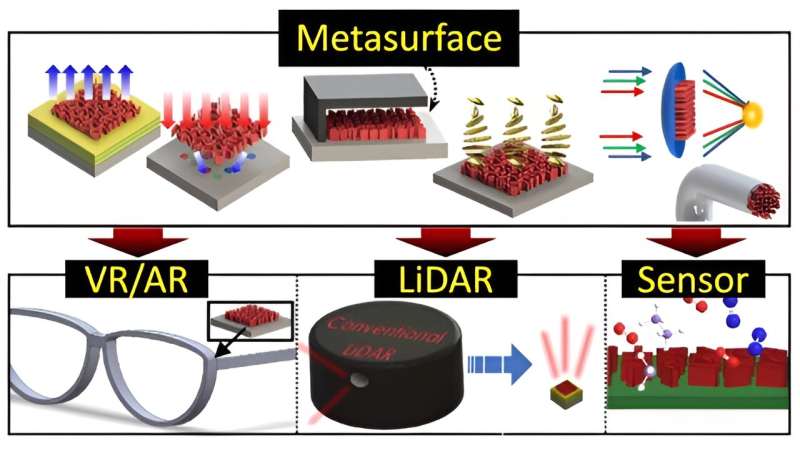This article has been reviewed according to Science X's editorial process and policies. Editors have highlighted the following attributes while ensuring the content's credibility:
fact-checked
peer-reviewed publication
trusted source
proofread
Micro-optical technology based on metamaterials takes center stage

Metasurfaces are artificial materials adept at manipulating perception. With metasurfaces allowing lenses to be reduced to one 10,000th the size of conventional lenses, they are generating considerable interest as optical components allowing miniaturization of optical systems for the next generation of virtual and augmented reality as well as LiDAR.
If metasurfaces become commercially viable, overcoming the challenges of complex manufacturing processes and high production costs, Korea could gain a significant technological edge in the field of nano-optics.
A collaborative research team led by Professor Junsuk Rho from the Department of Mechanical Engineering and the Department of Chemical Engineering with Ph.D. candidates Younghwan Yang, Junhwa Seong, Minseok Choi, and Junkyeong Park, (co-lead authors) from the Department of Mechanical Engineering at Pohang University of Science and Technology (POSTECH), and Dr. Gyoseon Jeon, Dr. Kyong-il Lee, and Dr. Dong Hyun Yoon from the Research Institute of Industrial Science and Technology (RIST) has published a paper summarizing research trends in a near-future micro-optical platform based on metasurfaces in Light: Science and Applications.
They also propose future research directions and methods for commercialization in the journal.
Historically, metasurface research has concentrated on the full manipulation of light's characteristics, resulting in a diverse array of optical devices such as metalenses, metaholograms, and beam diffraction devices. Nevertheless, recent studies have shifted their focus toward integrating metasurfaces with other optical components.
In their paper, the research team proposes a study of and applications for integrated metasurfaces. These integrated metasurfaces are optical components that can be combined with various standard optical components such as light-emitting diodes (LEDs) and liquid crystal display (LCD). For commercialization of metasurfaces, the research team suggested that future research in this field should focus on how to integrate metasurface into commonly used devices, making them applicable in everyday life.
Furthermore, the research team emphasizes the importance of collaboration between industry and academia, underscoring the impact that metasurface research can have on the future optical device industry and national competitiveness. They stressed that national-level support and cooperation are essential for the development of innovative optical platforms.
Professor Junsuk Rho explained, "Integrated metasurfaces complement existing electronic technologies and represent another innovative solution for a variety of applications." He added, "I hope there will be sustained efforts, research, and national support that will lead to even more innovative outcomes."
More information: Younghwan Yang et al, Integrated metasurfaces for re-envisioning a near-future disruptive optical platform, Light: Science & Applications (2023). DOI: 10.1038/s41377-023-01169-4
Journal information: Light: Science & Applications
Provided by Pohang University of Science and Technology




















